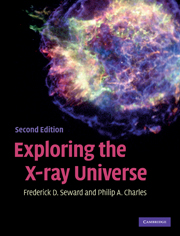Book contents
- Frontmatter
- Contents
- List of acronyms
- Foreword
- Chapter 1 Birth and childhood of X-ray astronomy
- Chapter 2 X-ray emission and interaction with matter
- Chapter 3 Tools and techniques
- Chapter 4 Solar system X-rays
- Chapter 5 X-ray absorption and scattering in the Interstellar Medium
- Chapter 6 Active stellar coronae
- Chapter 7 Early-type stars
- Chapter 8 Supernova explosions and their remnants
- Chapter 9 Neutron stars, pulsars, pulsar wind nebulae, and more supernova remnants
- Chapter 10 Cataclysmic variable stars
- Chapter 11 X-ray binaries
- Chapter 12 Black-hole X-ray binaries
- Chapter 13 Normal and starburst galaxies
- Chapter 14 Active galactic nuclei
- Chapter 15 Clusters of galaxies
- Chapter 16 The diffuse X-ray background
- Chapter 17 Gamma-ray bursts
- Index
- Plate section
Chapter 15 - Clusters of galaxies
Published online by Cambridge University Press: 05 June 2012
- Frontmatter
- Contents
- List of acronyms
- Foreword
- Chapter 1 Birth and childhood of X-ray astronomy
- Chapter 2 X-ray emission and interaction with matter
- Chapter 3 Tools and techniques
- Chapter 4 Solar system X-rays
- Chapter 5 X-ray absorption and scattering in the Interstellar Medium
- Chapter 6 Active stellar coronae
- Chapter 7 Early-type stars
- Chapter 8 Supernova explosions and their remnants
- Chapter 9 Neutron stars, pulsars, pulsar wind nebulae, and more supernova remnants
- Chapter 10 Cataclysmic variable stars
- Chapter 11 X-ray binaries
- Chapter 12 Black-hole X-ray binaries
- Chapter 13 Normal and starburst galaxies
- Chapter 14 Active galactic nuclei
- Chapter 15 Clusters of galaxies
- Chapter 16 The diffuse X-ray background
- Chapter 17 Gamma-ray bursts
- Index
- Plate section
Summary
Introduction
On the largest scale, the distribution of matter in the Universe is uniform, but on an intermediate level, galaxies are found in gravitationally bound aggregates. These ‘groups’ and ‘clusters’ exist in sizes ranging from a few galaxies to 10 000 galaxies. The gravitational potential which binds galaxies in a cluster also binds a cloud of hot gas which fills the space between and around the galaxies. This gas, the intracluster medium (ICM), has a temperature of tens of millions of degrees. It coexists with the galaxies and, although very diffuse, is a strong source of X-ray emission.
This hot gas was discovered unexpectedly in 1971 through the analysis of X-ray observations. Modern observatories have now measured the X-ray luminosities of hundreds of galaxy clusters, and the morphology of emission from many brighter clusters has been well mapped. The shapes of the gravitational potentials of these clusters have been derived and the mass of X-rayemitting gas determined. (The deeper the gravitational potential well, the faster the motion of the galaxies within the cluster and the greater the concentration of hot gas at the centre.) The mass of hot gas is typically 3–10 times greater than the mass derived from the visible luminosity of the galaxies.
The cluster gravitational potential which fits both X-ray and optical measurements requires the existence of a large hidden mass.
- Type
- Chapter
- Information
- Exploring the X-ray Universe , pp. 306 - 324Publisher: Cambridge University PressPrint publication year: 2010

